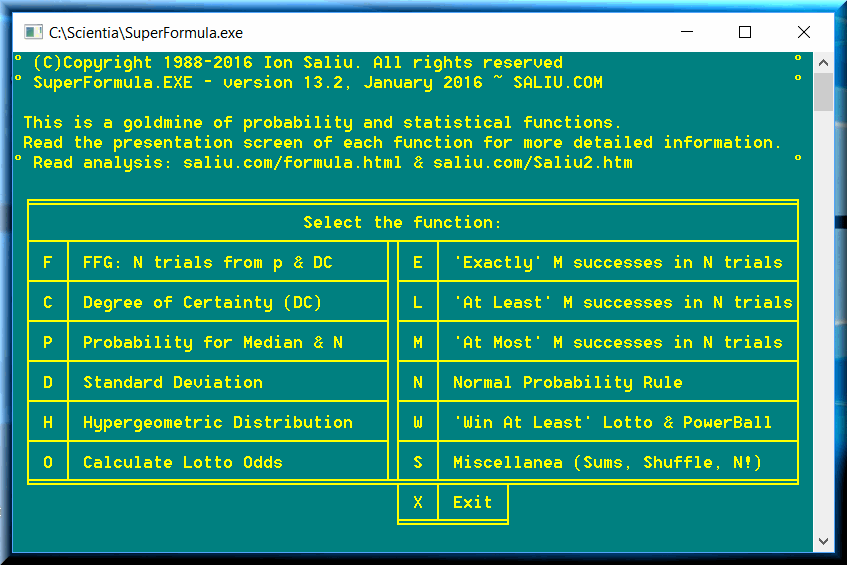
FORMULA Software, Probability, Statistics, Standard Deviation, Politics, Successes
By Ion Saliu, ★ Founder of Probability Theory of Life



Written on January 27, 2001; later updates.
• I upgraded FORMULA to calculate the standard deviation for binomial events (i.e., experiments characterized by two and only two outcomes: win or loss; success or failure). This is the theoretical or expected value of the standard deviation. The standard deviation can also be calculated post facto: after the experiment. Its name is self-explanatory. You can see in the WS-3 reports generated by LotWon a standard deviation for every filter. A filter goes up and down from an average value. The standard deviation calculates the positive average of all deviations (fluctuations) from an average norm.
The binomial standard deviation has great merit. It shows what fluctuation to expect. Before starting the coin toss, one can have an accurate idea of how many heads will come out in a number of trials (tosses). Or how many winning hands one can expect playing 200 blackjack rounds.
FORMULA software can save now to disk the standard deviation reports. Here is the report for 100 coin tosses.
The expected (theoretical) number of successes is: 50.
Based on the Normal Probability Rule: · 68.2% of the successes will fall within 1 Standard Deviation
The standard deviation for an event of probability
p = .5
in 100 binomial experiments is:
BSD = 5
from 50 - i.e., between 45 - 55
·· 95.4% of the successes will fall within 2 Standard Deviations
from 50 - i.e., between 40 - 60
··· 99.7% of the successes will fall within 3 Standard Deviations
From 50 - i.e., between 35 - 65
The perfect game of chance – coin tossing – has also the widest fluctuation (standard deviation). It's curious. Here is the report for rolling the cube 100 times. The probability to get any
point is 1 in 6.
The expected (theoretical) number of successes is: 17.
Based on the Normal Probability Rule:
· 68.2% of the successes will fall within 1 Standard Deviation
The standard deviation for an event of probability
p = .16666667
in 100 binomial experiments is:
BSD = 3.73
from 17 - i.e., between 13 - 21
·· 95.4% of the successes will fall within 2 Standard Deviations
from 17 - i.e., between 9 - 25
··· 99.7% of the successes will fall within 3 Standard Deviations
from 17 - i.e., between 5 - 29
Something worth mentioning here. Many players are strongly inclined to expect only the highest winning situations. In coin tossing, for example, some players always expect 65 successes in 100 trials! On the other hand, the static school of gambling advises players to always expect 35 successes in 100 trials. The binomial distribution formula of exactly S successes in N trials is of great help. You can use the same FORMULA to calculate the real probabilities of various numbers of successes. The results are slim to get exactly 35 (or exactly 65) successes in 100 tosses. We can notice that, for the most part, the successes are concentrated around the expected value (N * p).
The U.S. presidential election of 2000 was some political event. The event had also probabilistic merit. Theory of probability can play a positive role in assuring political fairness. There are situations when an election becomes a coin toss. That's normal; there is no problem in that. The problem is not to recognize a situation as such as a coin toss and handle it accordingly. We can see below a report for one million coin tosses. The standard deviation is only 500. Three times the standard deviation is 1500.
If a political candidate has no more than half the votes plus 3 SD, the election fails the coin toss test. It is possible that a new election will show the other candidate winning. But if a candidate wins the first election by more than 3 standard deviations, it is almost certain to declare that the election was not a coin toss. In my opinion, a new election should be set after any coin-toss situation. Now, if the new election brings the same under-3 standard deviationsresult, the winner should deserve the benefit of the doubt. It is certain that most voters would deal with a second election more responsibly. Moreover, more of those who did not vote the first time would get involved the second time around.
Hail to the chief!
The expected (theoretical) number of successes is: 500,000.
Based on the Normal Probability Rule:
· 68.2% of the successes will fall within 1 Standard Deviation
The standard deviation for an event of probability
p = 0.5
in 1,000,000 binomial experiments is:
BSD = 500
from 500000 - i.e., between 499,500 - 500,500
·· 95.4% of the successes will fall within 2 Standard Deviations
from 500000 - i.e., between 499,000 - 501,000
··· 99.7% of the successes will fall within 3 Standard Deviations
from 500000 - i.e., between 498,500 - 501,500



